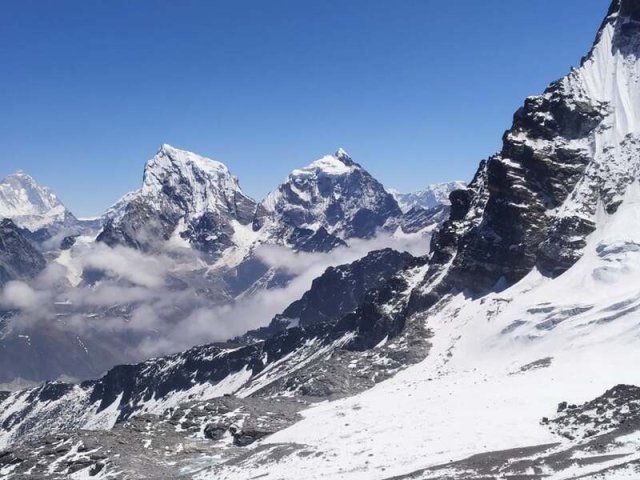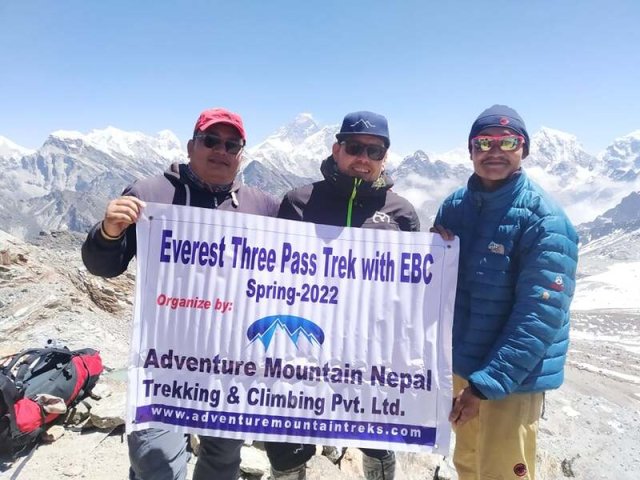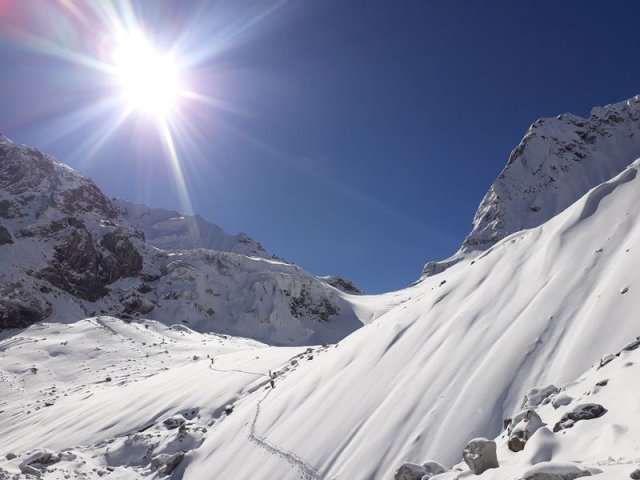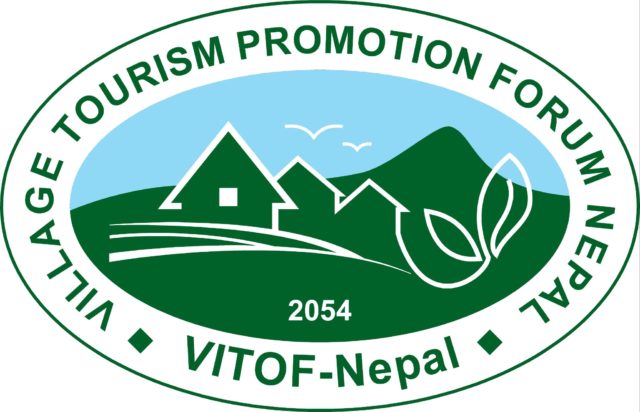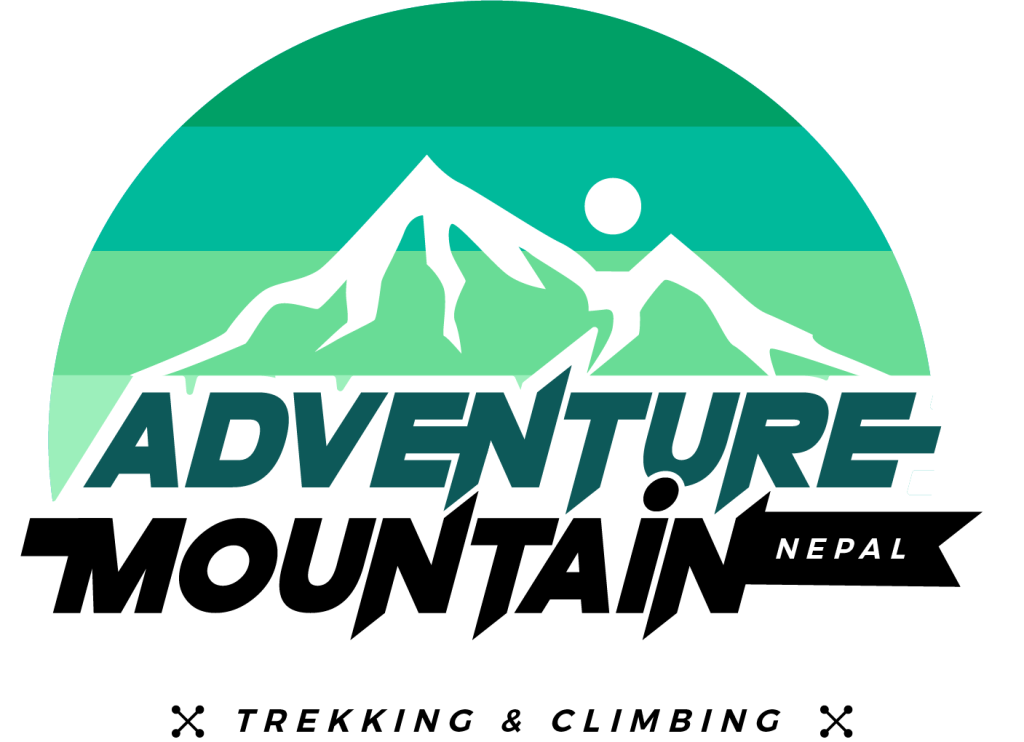The Everest Three Passes Trek is a challenging and rewarding trek in the Khumbu region of Nepal that takes you over the three highest passes in the area: Kongma La Pass (5,535 meters/18,159 feet), Cho La Pass (5,420 meters/17,782 feet), and Renjo La Pass (5,340 meters/17,520 feet). Along the way, you will also climb to the top of Kalapatthar (5,545 meters/18,187 feet) for breathtaking views of Mount Everest and the surrounding peaks. This trek offers a unique opportunity to explore the lesser-known areas of the Khumbu region, including the Nangpa La valley, the Sherpa village of Marlung, and the Monastery village of Thame. With its diverse landscapes, rich culture, and unparalleled views of the Himalayas, the Everest Three Passes Trek is a dream come true for adventurous trekkers.
Everest Three Passes Trek
The combined trek of three popular passes like Renjo La Pass, Chola Pass and Kongma La Pass
Trip Code
AMT - TREK - 102Best Season
Spring & Autumn
Trip Grade
⭐⭐⭐⭐
Max Altitude
Kongma La Pass (5,535/18,159ft)
Accomodation
Teahouses/Lodges
Transportation
Flight/Jeep or Bus
Meals
BB/Full Board
Group Size
Any
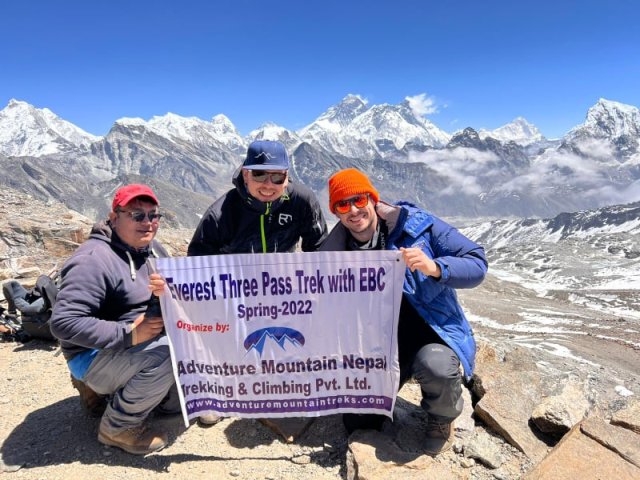
Introduction
Everest Three Pass Trek Overview
The trek begins with a scenic flight from Kathmandu to Lukla and continues through the beautiful Phakding village and the historical town of Namche Bazaar. From there, the route winds its way through the region in a clockwise direction, crossing the three high passes of Renjo La (5,370 meters), Cho La (5,420 meters), and Kongmala La (5,545 meters) before reaching the summit of Kalapatthar (5,545 meters/18,187 feet) and GokyoRi (5,483 meters/17,984 feet).
Along the way, trekkers will also visit the Gokyo Valley and the stunning Gokyo lakes, as well as the Ngozumpa Glacier. The stunning Gokyo valley is seen like a piece of heaven and the crystalline Gokyo lakes along with Ngozumpa Glacier appears to be magnificent. The special thing about this trek is we can unfold the panorama of the whole Khumbu region. Each small settlement in Khumbu region itself is the most captivating thing and the majestic beauty is unparallel with any other area.
The trek offers a unique opportunity to explore the diverse cultures and traditions of the Khumbu region, as well as its rich wildlife, including over 118 species of birds, endangered animals such as the Red Panda and Snow Leopard, and the Himalayan Tahr, Ghoral, Serow, and Himalayan black bear.
Trekkers will also have the chance to experience the warm hospitality of the local communities and to learn about their ancient Tibetan crafts and traditional housing and clothing. With its combination of stunning mountain views, rich culture, and diverse wildlife, the Everest Three Passes Trek is the ultimate adventure for trekkers in search of the ultimate trekking experience.
Trip Highlights:
- Everest Three Passes Trek is more adventurous and physical demanding trip than any other trekking routes of Everest region. After a short take-off and landing from Kathmandu to Lukla(2,800m/9,184ft altitude), the journey begins.
- The Three Passes trek is the utmost Everest experience as it ahead from north west to east in circular direction covering the three high passes. Namely – Renjo La(5,370m), Cho La(5,420m) and Kongmala La(5,545m) along with Kalapatthar (5,545 m) and Everest Base Camp (5,380m).
- Passing through Renjo La Pass (5,360m/17,581ft), Travellers get to enjoy at one of the highest settlements of Nepal, the beautiful Gokyo valley (4,750 m/15,580 ft) and GokyoRi (5,357 m) which the only place where we get to see astonishing view of the four highest Mountain in the world – Mt. Everest, (8,848m), Mt. ChoOyu (8,210m), Mt Lhotse (8,516m) and Mt Makalu (8,485m). Also the mesmerizing world's highest freshwater lake system, Gokyo lake makes everyone wonderstruck.
- The traveller can explore one of the captivating sections of Himalaya such as Tengboche monastery, the oldest Sherpa celibate monastery, lifestyle of Sherpa and monks during the adventure. Here, the tradition, culture, arts and lifestyle is unlike any other places thus it exhilarate them to learn more about the community.
- This route is home to a diverse range of Flora and Fauna than any other places. The forest in this area is a home for about 118 species of birds such as Himalayan monal, blood pheasant, red-billed cough, some rare mammal species including musk deer, snow leopard, Himalayan black bear and red panda.
Day by Day Itinerary
Remember:
Our travel planner can customize the itinerary outline as per your duration of stay, purpose of holiday and your preference. Cost of the package also depends upon level of service (deluxe, standard & budget) and as per the group size. You can easily CONTACT US at any time for any queries.Cost & Dates
Inclusions:
- Required numbers of time Airport pick up and drop off as per your flight schedule (international and domestic) including all required transfers in Kathmandu.
- 3 Night’s accommodation in touristic town of Kathmandu in BB Plan (one can choose budget, standard and deluxe)
- A day sightseeing tour in Kathmandu by private vehicle, highly experienced city tour guide.
- All the entrance fees of UNESCO heritage sites.
- Kathmandu–Lukla–Kathmandu both way flight ticket.
- Standard tea house (lodge) accommodation during the entire trekking as per mentioned in itinerary
- Three meals per day (Breakfast, Lunch and Dinner) during the entire trek as per mentioned in itinerary followed by 3 times tea/coffee per day. One can choose the meal from menu there.
- A duffel bag, Trekking Map and trekking pole Sleeping Bag, Down Jacket, Nepali SIM card (Rental basis, if needed)
- Sagarmatha (Everest) National Park Fee
- TIMS (Trekker’s Information Manual System) permit
- An experienced government certified local Trekking Guide
- Required numbers of highly experienced trekking porters (2:1 ratio)
- Staff’s foods, salary, insurance, accommodation, meals, transportation etc
- General first Aid Kit
- A certificate of appreciation (experience certificate) after completing the Trek
- Farewell Dinner in Kathmandu with cultural program.
- All government taxes and applicable paperwork
Exclusions:
- International Airfare
- Personal Travel Insurance (essential for high altitude trekking)
- Lunch in Kathmandu
- Personal expenses for bar, laundry, personal shopping, internet usages, hot shower and battery charge during the trek.
- Alcoholic beverage
- TIPS for Staff


